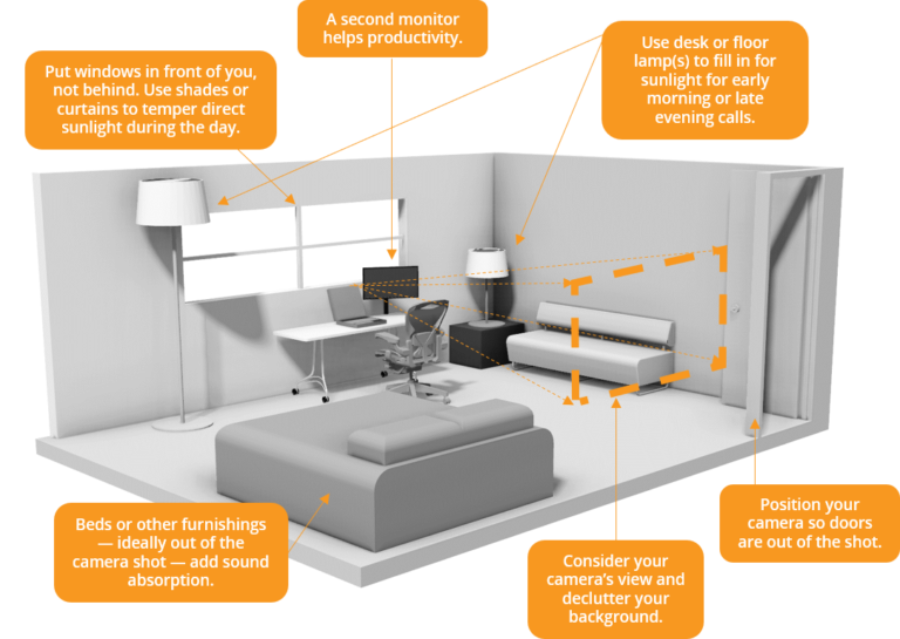
Top 10 Best Practices for Working From Home
Now that we’ve all moved to a remote-work strategy to maintain a safe and productive work environment during the COVID‑19 pandemic, the cracks in a work-from-home model are starting to reveal themselves. To help keep your team healthy and connected, we’ve put together this guide of best practices for maintaining productivity while working from home.

1. Choose a work environment for productivity.
Is your dining table overrun with cables and chaos? It might be time to find a more permanent place to work. When choosing where to set up your home office, think through how you’ll handle intrusions or distractions. If possible, choose an enclosed space like a guest bedroom or even a large closet with a door, and you’ll be better equipped to “commute” to your home office and focus on work while you’re there. An enclosed space also makes it harder for your kids or dog to wander in uninvited, although your colleagues will likely understand this is sometimes unavoidable, even with a door. Remember, they’re probably in the same boat as you, so give each other a break.
2. Treat your in-home work environment like you would any other work environment.
Implement a morning routine: Have a cup of coffee, check the news (try not to obsess!), and get dressed for work. Most of us will spend many hours on video calls throughout this pandemic, and while your hair doesn’t have to be perfect, having a morning routine that prepares you for your workday as if you were commuting to the office will help you get into a productive mindset.
3. Set a schedule and stick to it.
Having a predictable daily routine can stabilize your productivity, even if that means some of your workday happens after kids are in bed. Have a clear start and end time and leave your office when your workday is done. Add your schedule to your shared calendars so colleagues know the best times to reach you, and update your Teams, Zoom, Webex or Slack status if you’re going to be away from your “office.” Where practical, group calls together in your most available time-frame, and reserve off-hours for doing work assigned during calls.
4. Communicate expectations to other in-home workers, like partners or babysitters.
Many of us are now working from home alongside partners who are also working from home or caregivers who are running improvised in-home daycares. Communicate with your “co-workers” about your schedule and expectations, and plan together how you’ll each maintain productivity without compromising the other’s ability to work. Share calendars, coordinate calls, set boundaries around your work space, be social with each other (important!), and above all, keep it light.
5. Use technology to stay connected.
For workers whose jobs allow them the flexibility to work remotely, technology is the difference between success and failure. Specifically, video technology. Video technology like Teams, Skype, Zoom, FaceTime and others enable us to see each other and understand nonverbal cues like body language and facial expressions, which research shows are crucial to clear communication. In an era of extreme social distancing, good video communication habits are what will continue to connect us, at work and at home.
6. Test your network bandwidth. In fact, test everything.
Although people will be forgiving if your meeting has a few technical difficulties (remember, we’re all in the same boat!), you can make your life easier by testing a few things up front. First, check your network speed. If your home network is slower than your office network, consider downloading Frozen II to your kids’ iPad so they aren’t trying to stream it while you’re on a video call. Also, consider a hardwired connection instead of WiFi for any bandwidth-heavy activities. Next, check your video and audio settings to make sure you can be seen and heard. While you’re at it, make sure you know where the mute button is on every platform you might use in this new environment. If you have a dog or a mail carrier or both, you’re going to need it. Lastly, test your in-call settings with a friend or colleague before you lead a meeting with your client or CEO. Learn how to share a window, application or specific file instead of your entire desktop so you can be confident viewers are seeing the PowerPoint you’re delivering rather than the IMs from your teammate that can pop up at the exact wrong moment or the cat video that’s keeping you sane in these trying times.
7. Now that your video setup is good enough, make it better.
When Waveguide works with clients to design video-friendly conference rooms, we consider the whole environment. You can do that for desktop video calls, too. The most important part of a good video call is adequate lighting so callers can see your face and the nuances in your facial expressions clearly. To light your face evenly, try putting some soft, ambient lighting such as a table lamp with soft bulbs or a window with light-colored shades in front of you, behind your webcam. Avoid the harsh light of a desk lamp and avoid positioning yourself with a bright window behind you. Put your camera directly in front of your face, just above eye level, so you’re looking slightly up, not down. You can get a portable webcam to put on top of your laptop or desktop for about $20 online, and your chin will thank you for it. Try to minimize the activity in view of your webcam so callers can focus on your face and your message instead of attention-stealing clutter. Ditch busy patterns, turn off lamps or other lights behind you, close shades and doors, tidy up, and if you can, use temporary contact paper for contrast to really help your face pop. Add some sound-absorbing finishes like throw pillows or blankets (these will come in handy for No. 9) so it doesn’t sound like you’re in a tunnel, and use a headset or earbuds to improve your audio signal. Got some house plants? Throw in a couple of those, too, because plants make people happy. Now you’re ready for your close-up.

8. Brush up on your written communications skills.
While video has replaced many of your meetings, ad hoc watercooler conversations are now happening in Teams, Slack or other instant messaging channels that don’t always have spellcheck. Keep your writing brief and clear, and when in doubt just IM, “Gotta sec?” and move to video.
9. Take breaks.
Working from home can be successful for workers of all attention types if you allow yourself time to focus AND allow yourself time to take breaks. Studies show that short breaks every 90 minutes refresh your focus so you can get more done. It’s science.
10. Talk to each other.
Above all else, find ways to connect with your people. Research shows we live longer when we have strong social connections, so the isolation and loneliness of social distancing can have a negative impact on workers’ productivity, and worse, their mental health. Instead of letting isolation control our collective narrative, be intentional about connecting with your colleagues, your parents, your friends. Instead of email, try instant messaging, “Gotta sec?” and get on video. And make sure you don’t keep that cat video to yourself.
As your partners in digital communication transformation, Waveguide is here to help you elevate your remote-work strategy. Send “Gotta sec?” to Julie Nattis, and we’ll help narrow the digital distance between you and your teams.
+++
Originally published on March 18, 2020 and updated July 30, 2020 via Waveguide.
+++
What We Were Talking About in 2019: Titans players indulge in newly transformed dining hall
What We Were Talking About in 2018: Consuelo's Cafe: Meet Regina
At FLIK Hospitality Group we believe in great food, great service, and great people. Our wellness first approach ensures our food supports healthy and delicious choices, specially curated by our team of culinary experts and registered dietitians. At FLIK, we believe in seasonality in sourcing our ingredients and providing a customized approach to the culinary and hospitality needs of each client. Our dedication to providing quality hospitality service is unparalleled in the industry.
Have feedback or questions for our team? Email us at flikblog@compass-usa.com.
Interested in working with us? Apply today!